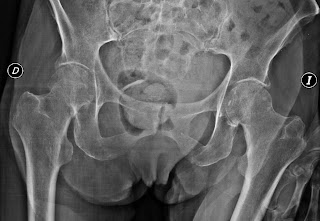 |
| En rojo fractura vertebral y en verde fractura vertebral después de cifoplastia |
Hay que tener en cuenta que las fracturas por compresión en su mayoría son ostoporóticas, que son una gran causa de invalidez, dolor crónico y que contribuyen a disminuir la expectativa de vida del paciente si es sobre todo anciana.
El tratamiento inicial consistirá en analgesicos, relajantes musculares, una ortesis de comfort y fisioterapia. Ante el fracaso del tratamiento (2 a 6 semanas de tratamiento conservador), está indicado en fracturas agudas la cifoplastia con balón. Es un procedimiento no inocuo (Se han reportado estenosis de canal, fuga de cemento, embolismo pulmonar) pero bastante efectivo y menos agresivo que una cirugía abierta, para el dolor, tras una fractura aguda que requiere de un radiologo experimentado, un anestesista y de un cirujano de columna o neurocirujano al llamado.
Another complaint frequently found in the ER. Is lumbalgia. If you face an od patient with lumbar pain and a history of a fall, after a good anamnesis and exploration you must suspect a vertebral fracture. You can make the precise diagnosis with an AP and lateral spine radiographs.
Most of the osteoporotic vertebral fractures are in elderly population, they are a great cause of disability, chronic pain and contribute to shorter life expectancy.
The initial treatment consist of analgesics, muscle relaxants, orthotic devices and physiotherapy. If it fails it is indicated the kyphoplasty (introduce by transpedicular approach a ballon and expand the vertebra and keep it expanded by cement augmentation). It is not a harmless procedure (it´s been reported spinal stenosis after cement leakage, cement embolism) but it is very effective and less agressive than an open surgery. Relief pain after an acute fracture. You always need an experience radiologist, an anhestetist and a spinal surgeon on call.



